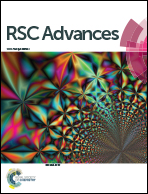A novel nitrogen heterocycle platform-based highly selective and sensitive fluorescence chemosensor for the detection of Al3+ and its application in cell imaging†
Abstract
In the study, a highly selective and sensitive fluorescence sensor derived from nitrogen heterocycle was synthesized and characterized. By the fluorescence experiments, it was found to show a higher response toward Al3+ than other commonly coexistent metal ions in C2H5OH/H2O media (pH = 7.2). Moreover, the large binding constant (3.44 × 1014 M−1) between Al3+ and the sensor was calculated by fluorescence titration experiment. In addition, the synergistic effect mechanism due to photoinduced electron transfer (PET) and C![[double bond, length as m-dash]](https://www.rsc.org/images/entities/char_e001.gif) N isomerization was deduced according to the fluorescence behavior. In addition, the fluorescence imaging in living cells was studied systemically, which exhibited high fluorescence sensing activity toward Al3+.
N isomerization was deduced according to the fluorescence behavior. In addition, the fluorescence imaging in living cells was studied systemically, which exhibited high fluorescence sensing activity toward Al3+.



 Please wait while we load your content...
Please wait while we load your content...